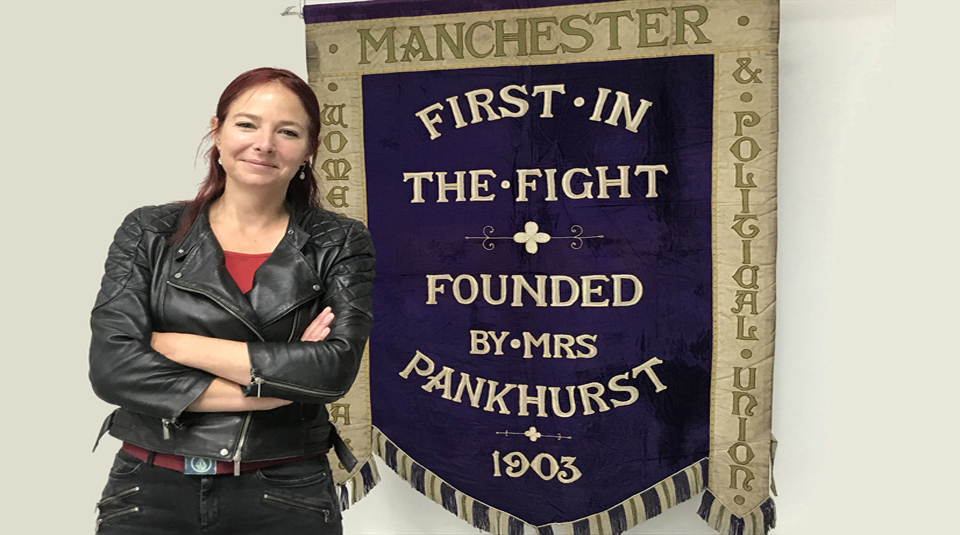
People’s History Museum’s (PHM) Head of Collections & Engagement Jenny Mabbott tells us about the very special banner in the museum’s collection that appeared in Industrial Revolution Manchester, the final episode of Channel 4 show Britain’s Most Historic Towns, with Professor Alice Roberts.
The banner highlights the crucial role that Manchester played in the campaign for votes for women. Around its edges in horizontal letters are the words ‘Women’s Social and Political Union’ (WSPU), and in big vertical letters occupying the centre of the banner, are the words ‘First in the Fight, Founded by Mrs Pankhurst, 1903’. This is a clear reference to the fact that the WSPU, also referred to as the ‘suffragettes’, was founded by Emmeline Pankhurst in Manchester in 1903.
The banner was made in 1908 and used the new WSPU colour scheme of purple for dignity, white for purity and green for hope. It was first unfurled in central Manchester’s Stevenson Square on 20 June 1908 by Rachel Scott, first secretary of the WSPU. Stevenson Square was often the starting point for marches and protests, and today is still a site of action, with a mural to George Floyd appearing in summer 2020 at the height of Black Lives Matter demonstrations taking place across the world.
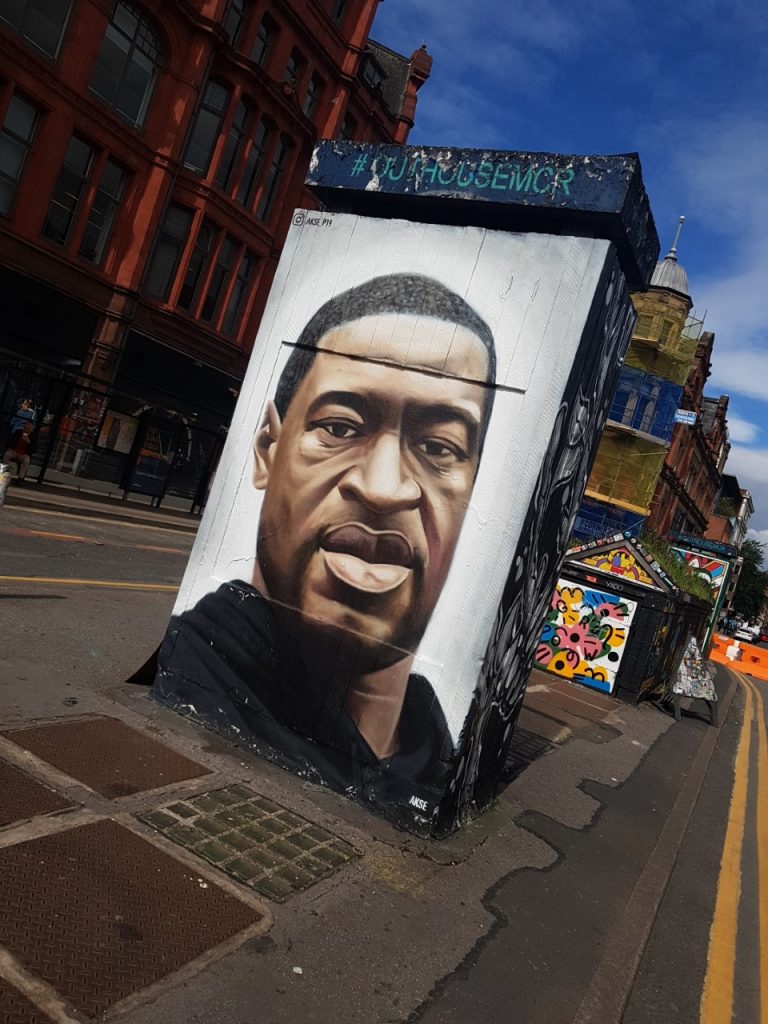
The next day the banner was taken to the 1908 Women’s Sunday rally in Hyde Park, London, attended by around 500,000 people! It made an appearance again a month later on 19 July 1908 at a rally in Manchester’s Heaton Park; this time it was in prime position on the hustings with Emmeline Pankhurst as she addressed the crowds.
The significance of the ‘First in the Fight’ message was to remind the wider WSPU movement, which by this time had moved their headquarters to London, that radical Manchester was the place where this incredible movement had begun!
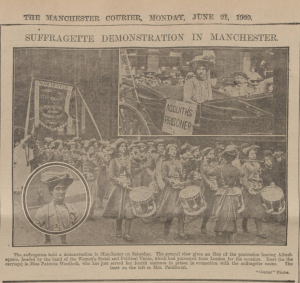
The Manchester suffragette banner was made by Thomas Brown & Son, Manchester. They were a well known maker of church banners in the local area. Many aspects of ecclesiastical design can be seen in the style of the banner, including the lettering which is similar to that seen on many Sunday School banners, and the embroidery which is a key feature of ecclesiastical design patterns.


The Manchester suffragette banner was looked after by suffragette, embroider and factory worker Elizabeth Ellen Chatterton who was born in Salford in 1857. The family story tells of her embroidering the banner in 1908. We think Elizabeth Ellen may have worked at Thomas Brown and Sons, although the surviving records do not allow us to conclusively prove this theory.
The banner was looked after by Chatterton and later by her family in Salford, then Manchester before moving to Leeds. Family photos shared with People’s History Museum, show her descendants standing proudly with the banner in 1989.
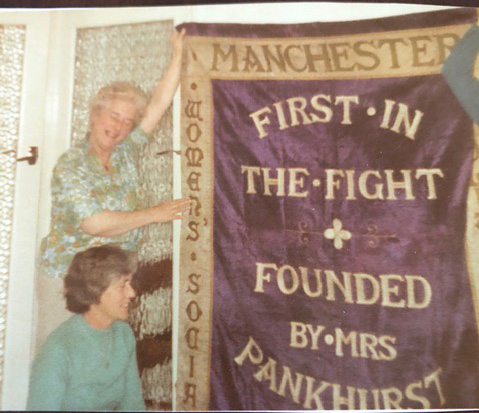
However, in 2003/2004, the banner vanished following a house clearance. Elizabeth Ellen’s great granddaughter Suzanne Bath recalls making frantic enquiries to neighbours, local builders, house clearers, clergy, estate agents and charity shops to find the banner but to no avail. The next the family was to hear of the banner was in an article in The Guardian in September 2017, once PHM had acquired the banner. When Suzanne and her daughter were reunited with the banner in The Conservation Studio at PHM there were tears of joy!
The journey for PHM to acquiring the Manchester suffragette banner began in June 2017 with a simple listing on saleroom.com for a ‘1903 Manchester suffragette banner’. Researcher, writer and suffrage antique dealer Elizabeth Crawford kindly alerted Salford’s Working Class Movement Library about the sale initially; the Library was PHM’s partner at that time in a National Lottery Heritage Fund Collecting Cultures project called ‘Voting for Change’, and both Elizabeth and the Library encouraged PHM in the pursuit of the banner. The banner was due to be auctioned at Gary Don auctioneers in Leeds the following week.
On the day of the auction, former PHM Conservator and banner specialist Vivian Lochhead and I went to view the banner. Further examination of its style and condition enabled us to authenticate the banner. Vivian discovered the maker’s label ‘Thomas Brown and Sons, Manchester’ in the banner sleeve (the section at the top for the pole). Sadly, PHM was outbid in the auction and I left devastated that we would never bring the banner home to Manchester. Thankfully, the dealer who had purchased the banner agreed to sell it to PHM and we began a highly successful crowdfunding campaign. We also made a successful application to the Arts Council England/V&A Purchase Grant Fund to complement existing funding PHM had secured from The National Lottery Heritage Fund’s Collecting Cultures programme. The banner finally made it to The Conservation Studio at PHM in late August 2017.
We discovered that following the house clearance the banner had been in the safe keeping of a small charity called HOPE (Halton Moor and Osmandthorpe Project for the Elders). The banner, we are told, was stored in a filing cabinet; so miraculously had escaped light damage and arrived with its beautiful and vibrant purple velvet intact!
There was considerable public and media interest in the banner and in September 2017 it made a special trip to London to appear on the BBC’s The One Show alongside 2016 US Democratic presidential nominee Hilary Clinton. In 2018, the centenary year of the passing of the Representation of the People Act, in which all men and some women gained the right to vote in Britain, the banner took centre stage in PHM’s commemorations and went on public display for the first time in the exhibition Represent! Voices 100 Years On.
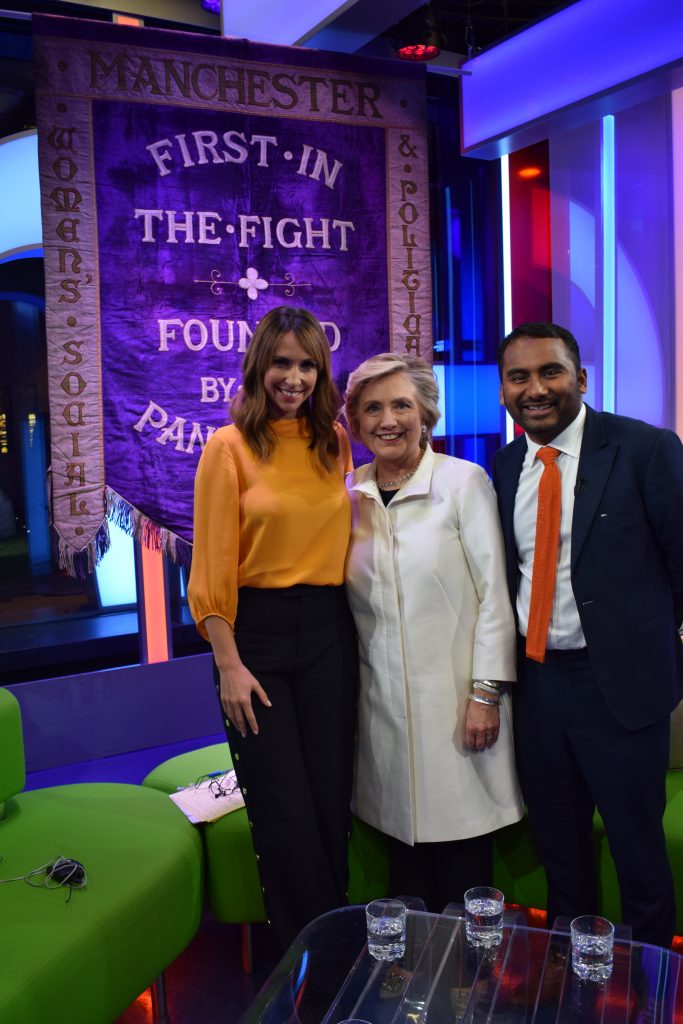
The Manchester suffragette banner cannot be permanently on display because one of the major things that causes objects to age or wear out is damage caused by light. As the purple dye featured in the banner is so important to its place within the history of the suffragette movement, we are careful about the light and environmental conditions it is exposed to, ensuring that it is as well preserved for the future as possible. However, from 21 June 2023 until 7 January 2024 it will be on display in Main Gallery One of the museum to mark its 115th birthday, linking back to its first public appearance when the banner stood alongside Emmeline Pankhurst in Manchester’s Stevenson Square.
Also new for Summer 2023 will be two new trails round the main galleries, the Radical women trail and the Little suffragettes trail for younger visitors. Jenny Mabbott will be carrying out a series of Radical women tours throughout the summer that visitors can join her on. On Thursday 22 June, Thursday 20 July and Thursday 21 September she will introduce the story of the suffragettes alongside that of other radical women who have also campaigned for equity, equality and a fairer world for all.
The banner made a special appearance in the final episode of Channel 4’s series Britain’s Most Historic Towns with Professor Alice Roberts. You can watch it again online in Series 3, Episode 7.
The Manchester suffragette banner is one of PHM’s ten treasures; ten pieces picked out by the museum team that they believe capture the ethos, spirit and importance of the museum’s collection.
If you believe in our work, and want to help us grow our collection, you can support us by becoming a Radical Friend and giving just £3 a month.
Teach about Votes for Women with a learning resource and book a self guided visit for your learning group to explore further.
An earlier version of this blog was first published on 15 December 2020.